The 2025 World Humanoid Robot Games
A Spectacle of Innovation, Competition, and Comical Chaos in Beijing's Landmark Robotics Event
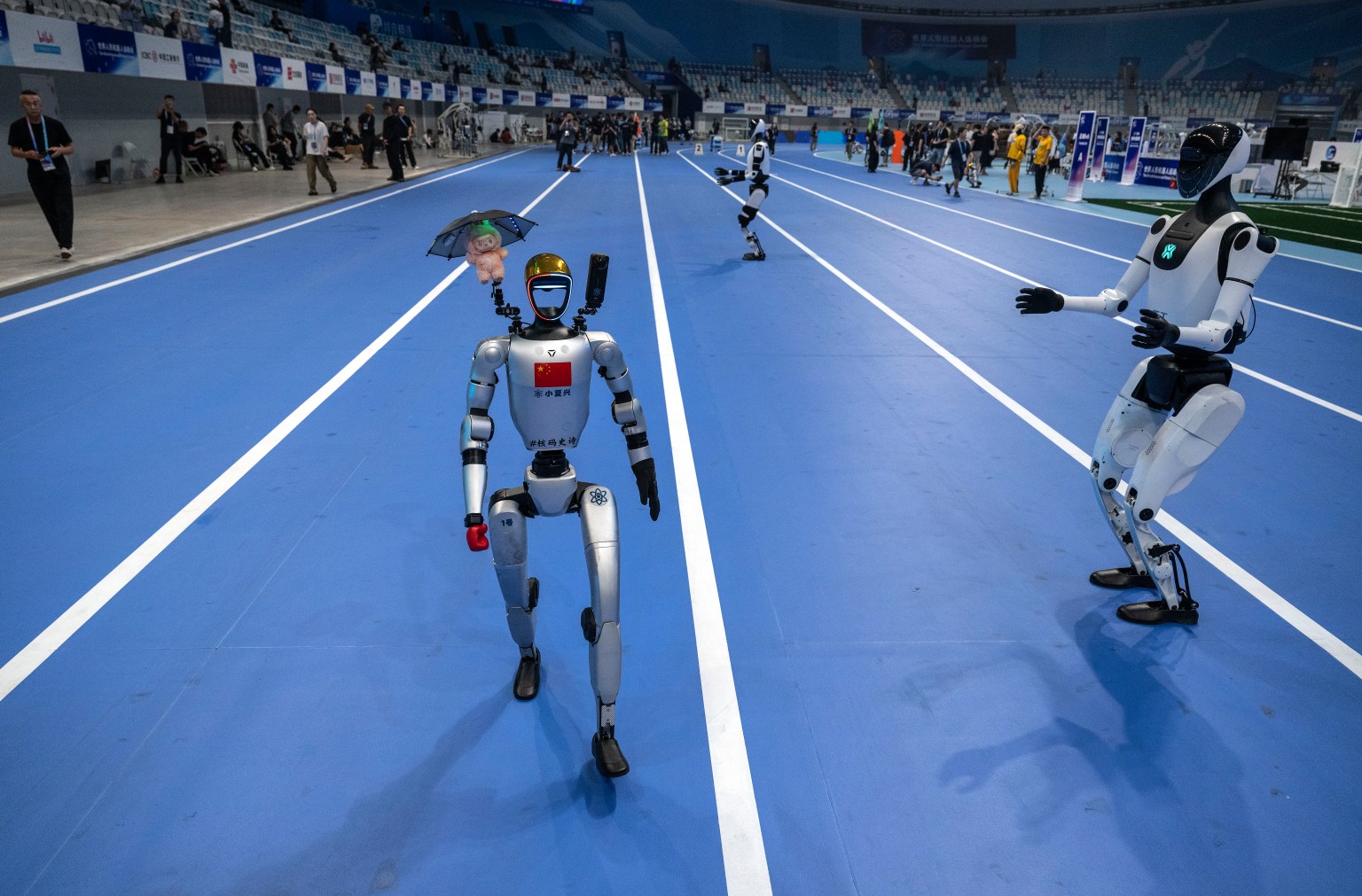
A Historic Milestone in Robotics
In a landmark event for the fields of robotics and artificial intelligence, Beijing, China, hosted the inaugural World Humanoid Robot Games (WHRG) from August 14 to August 17, 2025 [199]. This pioneering competition, often dubbed the "Robot Olympics," marked the first time a multi-sport event was held exclusively for humanoid robots, drawing global attention to the rapid advancements in embodied AI.
Event at a Glance
Venue & Scale
- National Speed Skating Oval ("Ice Ribbon")
- 280 teams from 16 countries
- Over 500 humanoid robots
- 127 different brands represented
Key Highlights
- Unitree H1 double gold medalist
- Chaotic five-on-five soccer matches
- Comical mishaps and falls
- Robot performances and fashion show
Grand Opening Ceremony
Robot Performances
The opening ceremony showcased the artistic capabilities of humanoid robots through dynamic performances. Robots demonstrated hip-hop dancing with synchronized routines, played musical instruments including keyboards, guitars, and drums, and even featured a six-armed robot performing on drums alongside human musicians [565].
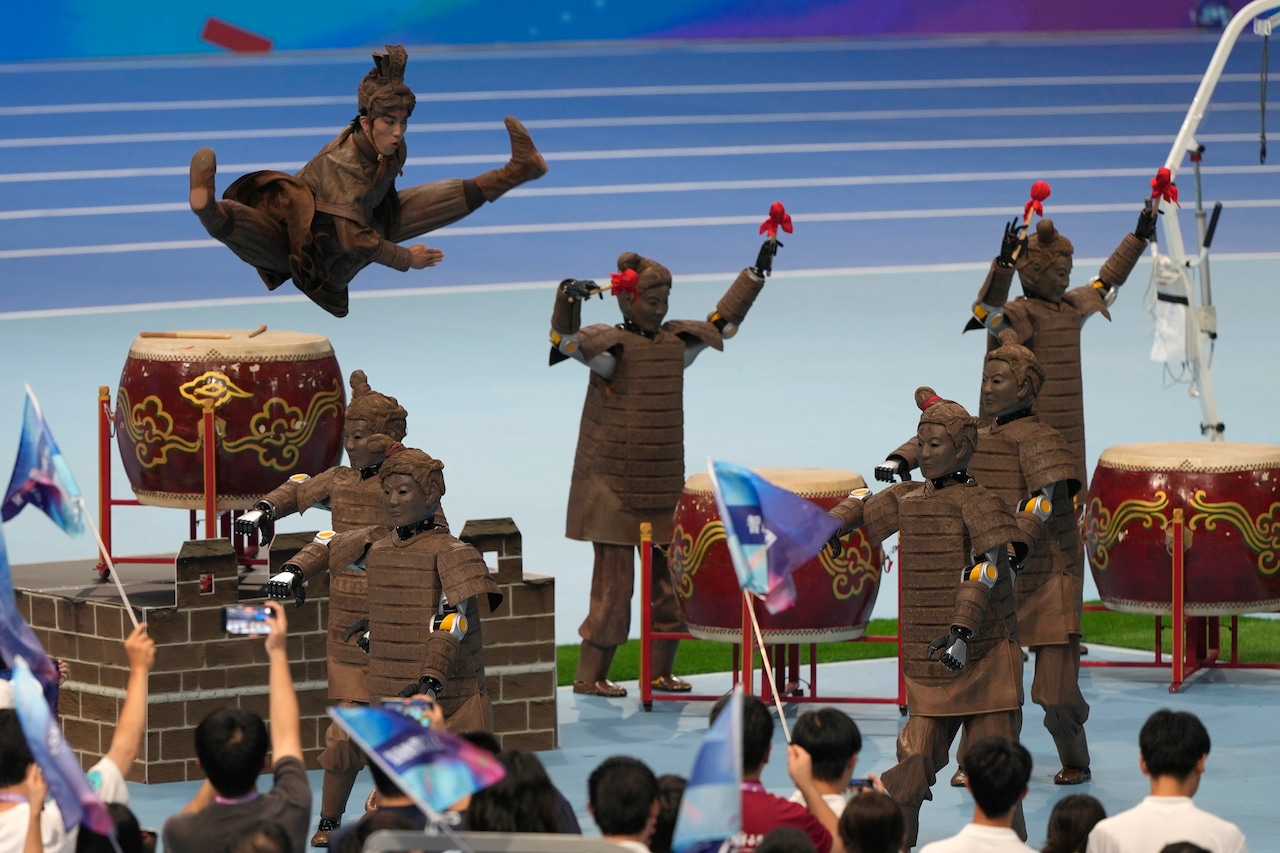
Cultural Displays
The ceremony featured robots dressed as iconic Chinese cultural figures, including the Monkey King (Sun Wukong) and Terracotta Warriors [612]. The Terracotta Warrior robots, adorned in 3D-printed armor, performed flawless dance routines alongside human dancers, creating a powerful fusion of technology, art, and history.

Fashion Show & Sports Demonstrations
In a unique segment, robots and human models showcased customized clothing featuring 3D-printed accessories and intricate embroidery [640]. The demonstration wasn't without mishaps - one robot model took a tumble on the runway and had to be carried off stage by human assistants [565].
Fashion Fail: A robot model fell during the fashion show runway walk, providing one of the event's most memorable and humorous moments.
The ceremony concluded with live demonstrations of five-a-side robot soccer and freestyle combat boxing, giving spectators a preview of the competitive events to come.
Competition Highlights
Track and Field Events
Unitree H1 Dominates Racing Events
The Unitree H1 robot from Hangzhou-based Unitree Robotics emerged as the star athlete of the Games, securing gold medals in both the 1500-meter and 400-meter races. In the 1500-meter event, the H1 crossed the finish line with a remarkable time of 6 minutes and 34.40 seconds, while the Tiangong robot finished second with 6 minutes and 55 seconds [199].
Double Champion: Unitree H1 became the first robot to win multiple gold medals in the inaugural World Humanoid Robot Games.
The 100-meter sprint, described as the "battlefield everyone wants to win," showcased robots reaching speeds up to 12 km/h, though not without comical moments including false starts and face-plants.
Soccer Matches
Five-on-Five Chaos
The five-on-five soccer matches provided a chaotic and often hilarious spectacle, with robots frequently colliding with each other and falling over in tangles of metal limbs [575]. Despite the apparent disorganization, these matches served as valuable testing grounds for swarm intelligence and collaborative decision-making technologies.
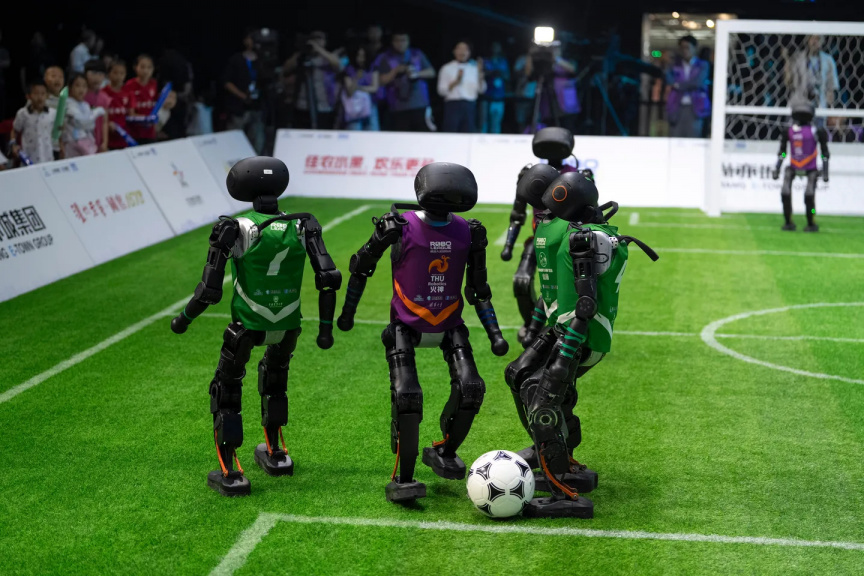
Three-on-Three AI Tournament
The three-on-three AI-powered tournament showcased more advanced autonomous decision-making, with robots relying solely on AI-driven strategies to navigate the pitch, control the ball, and score goals [642]. These matches demonstrated real-time decision-making, coordinated teamwork, and self-recovery capabilities.
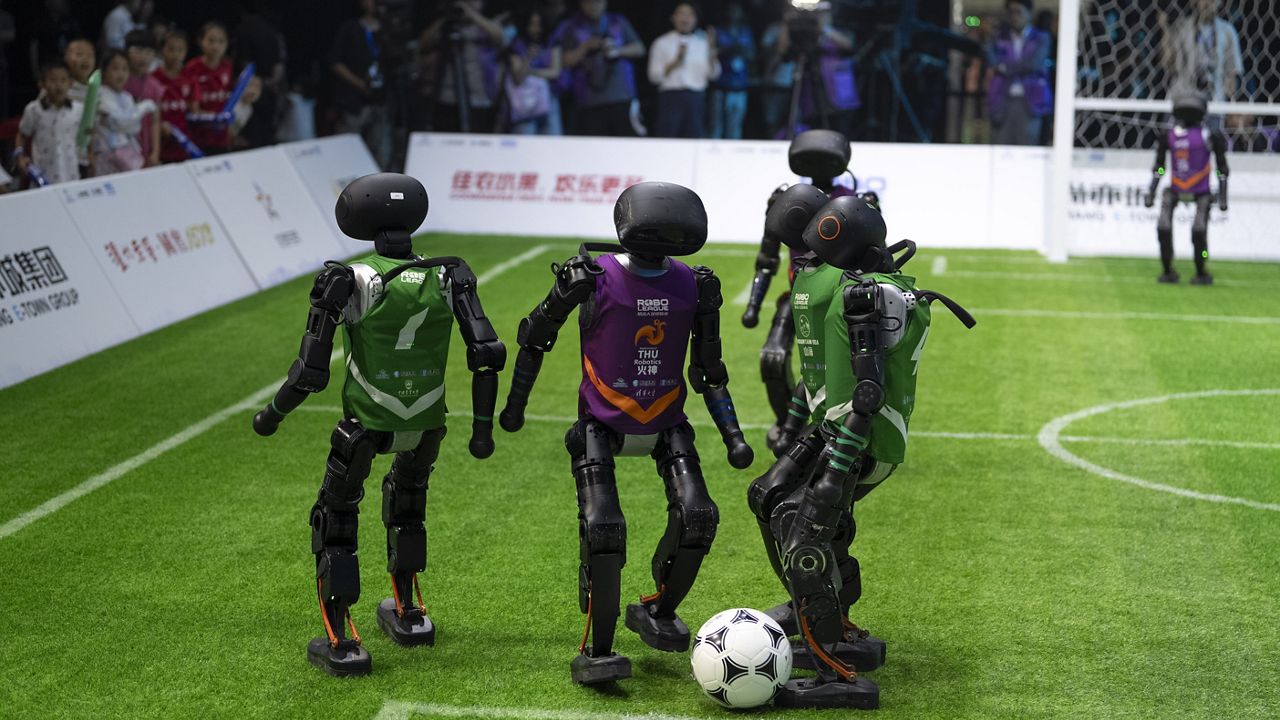
Other Competitive Events
Diverse Challenges
Boxing & Combat
Robots demonstrated power, agility, and precision in choreographed fight sequences, showcasing advanced control systems.
Table Tennis
A test of hand-eye coordination and reflexes, with robots attempting lightning-fast reactions and precision shots.
Material Handling
Practical demonstrations of dexterity and object manipulation in simulated warehouse and pharmacy environments.
Funny Moments & Robotic Fails
On-Field Collisions and Tumbles
Soccer Match Mayhem
The soccer matches provided constant entertainment through comical collisions. In one memorable moment, four robots crashed into each other and fell in a tangled heap of metal limbs, much to the amusement of the crowd [575]. The robots' lack of spatial awareness and inability to anticipate movements led to a series of hilarious mishaps throughout the matches.
Robot Pile-Up: Four robots collided simultaneously, creating a tangled heap that required human intervention to resolve.
Running Event Stumbles
The running events saw several robots collapsing mid-sprint, their mechanical limbs giving out under the strain of competition. One robot was running at full speed when it suddenly collapsed, its body crumpling to the ground in a heap. These dramatic falls highlighted the physical limitations of current robotic technology and the challenges of creating machines that can withstand athletic competition.
Off-Field and Performance Mishaps
Fashion Show Fumble
During the opening ceremony fashion show, a robot model dressed in fashionable attire lost its balance and fell to the ground, requiring two human assistants to carry it off stage [420]. The incident provided one of the most memorable and lighthearted moments of the Games.
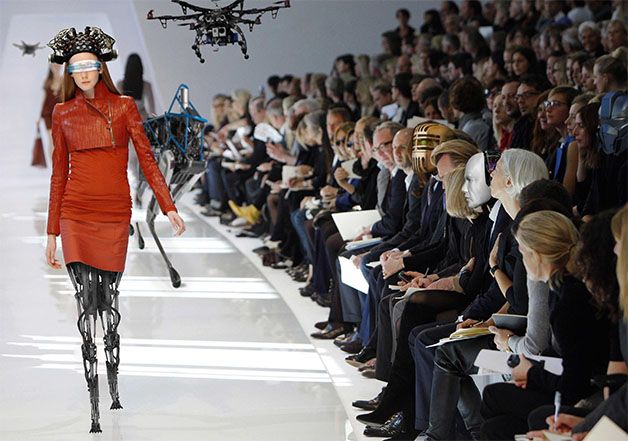
General Awkwardness
Throughout the event, robots struggled with basic movements, displaying jerky and uncoordinated motions. The general awkwardness served as a reminder of the challenges still facing humanoid robotics, while also providing constant entertainment for spectators who found humor in the robots' earnest but often misguided attempts at complex tasks.

Technical Innovations
Leading Robot Models
Unitree H1
The star athlete of the Games, winning double gold in track events. Known for advanced engineering and athletic capabilities.
Booster Robotics T1
Notable competitor in soccer matches, demonstrating agility and coordination on the pitch.
Yobotics
Strong contender in the 1500-meter race, showcasing endurance and stability in long-distance running.
Key Technological Features
AI-Driven Strategies
The Games showcased robots capable of AI-driven strategies and real-time decision-making, particularly in the three-on-three soccer tournament where robots operated fully autonomously. These systems demonstrated the ability to analyze environments, predict opponent movements, and make strategic decisions without human intervention.
Autonomous Operation
The event featured a mix of autonomous and remotely controlled robots. The autonomous systems demonstrated remarkable intelligence, performing complex tasks without human intervention, while highlighting the ongoing challenges of balancing complete autonomy with reliable performance.
Self-Recovery Mechanisms
Some robots demonstrated impressive self-recovery capabilities, able to get back up after falls without human assistance. This feature represents a significant advancement in robotic resilience and independence, though many robots still required human intervention when falling.
Challenges and Limitations
Balance & Stability
Maintaining balance during dynamic movements remains a primary challenge, with frequent falls highlighting current limitations.
Team Coordination
Coordinating multiple robots in dynamic environments proved challenging, with frequent collisions and miscommunication.
Energy Efficiency
Endurance limitations forced several robots to retire from competitions due to overheating or energy depletion.
Future Outlook & Industry Impact
Advancing Humanoid Robotics
From Laboratory to Real-World Applications
The 2025 World Humanoid Robot Games marked a significant milestone in transitioning humanoid robotics from laboratory research to real-world applications. The event provided a valuable testing ground for robots in dynamic, unpredictable environments, accelerating the development of robust, reliable, and versatile systems capable of practical implementation across various industries.
International Collaboration
The Games fostered unprecedented international collaboration, bringing together 280 teams from 16 countries. This global cooperation accelerates technological advancement through shared knowledge, diverse approaches, and collective problem-solving in the field of humanoid robotics.
Learning from Failure
The event highlighted the importance of experimental approaches and learning from failures. Each mishap and challenge provided valuable data for improving robot design, control algorithms, and performance capabilities, driving rapid innovation in the field.
China's Leadership in Robotics
Showcasing National Strength
The 2025 World Humanoid Robot Games served as a platform for China to showcase its national strength in artificial intelligence and robotics. The event demonstrated the country's commitment to becoming a global leader in this emerging technological frontier, with Chinese companies like Unitree Robotics, Fourier Intelligence, and Booster Robotics leading the competition.
Technological Prowess
- • Leading robot manufacturers based in China
- • Advanced AI and machine learning capabilities
- • Strong academic participation from top universities
Strategic Vision
- • First international robot sporting event
- • Open platform for global cooperation
- • Investment in next-generation technology
Looking Forward
As the first event of its kind, the 2025 World Humanoid Robot Games have set a foundation for future competitions and technological development. The lessons learned, partnerships formed, and innovations demonstrated will accelerate the evolution of humanoid robotics, bringing us closer to a future where these machines work alongside humans to create a better world.